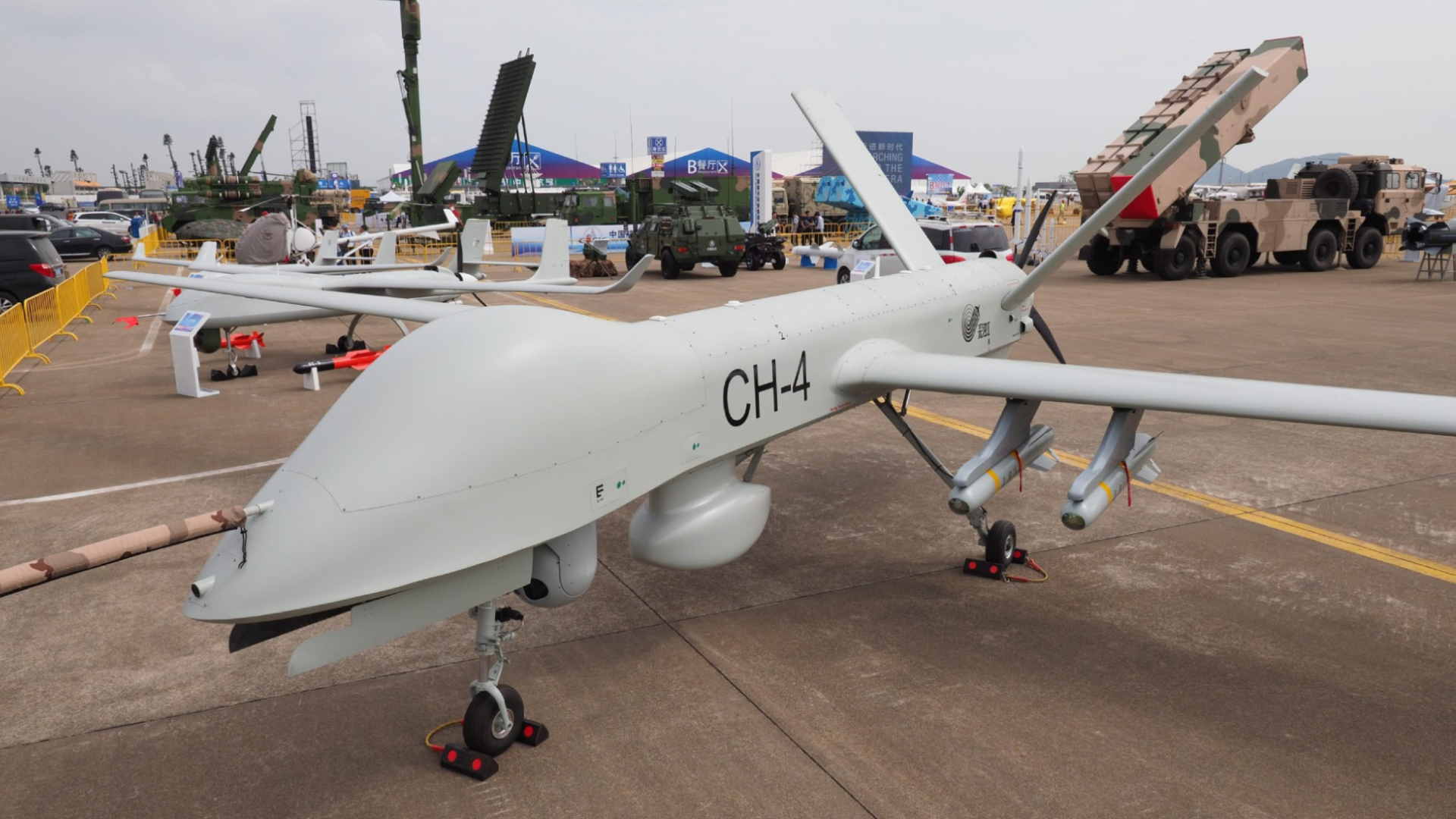The People’s Liberation Army Ground Force (PLAGF) has recently unveiled its latest groundbreaking military arsenal addition – the KVD002 unmanned reconnaissance and strike aircraft, marking a significant development in China’s capabilities.
This medium-altitude long-endurance unmanned aerial system (UAS), equipped with AR-1 air-to-surface missiles (an AGM-114 Hellfire clone) and advanced reconnaissance devices, demonstrates Beijing’s commitment to modernizing its armed forces.
This analysis delves into the features and potential applications of the KVD002, its speculated connection to the CH-4 drone, and the implications of its reported operations near Taiwan.
What We Know So Far: Features and Capabilities
Debuting last Sunday at the 6th China Helicopter Exposition, the KVD002 is said to represent a significant advancement in the Asian power’s unmanned aerial capabilities. It has dual-role capabilities, encompassing reconnaissance and precision strikes, highlighting its strategic importance.
Armed with two AR-1 missiles, it poses a formidable threat to hostile air defense systems, armored targets, and fortifications in alignment with integrated air-ground plans.
Additionally, according to reports, its ability to collaborate with helicopters for reconnaissance, escort services, and target guidance indicates a versatile operational capacity.
One of the notable features is its capability for short takeoffs and landings on elevated plateaus, demonstrating adaptability to various terrains. This feature enhances its potential for operations in rugged or mountainous regions, expanding its utility beyond conventional environments.

Potential Connection to CH-4 Drone
While the PLA has not officially disclosed the KVD002’s developer, reports suggest a likely connection to the Cai Hong 4 or CH-4 drone produced by the state-owned China Aerospace Science and Technology Corporation (CASC).
The CH-4’s resemblance to the US-made MQ-9 Reaper drone is apparent, and its popularity, having been purchased by over ten countries, attests to its effectiveness. However, neither the PLAGF nor the manufacturer has officially confirmed the relationship between the KVD002 and the CH-4.
More on the CH-4, as reported, the Chinese-built drone model boasts an impressive operational endurance, capable of remaining airborne for up to 30 hours at a stretch. While it can achieve a maximum speed of 230 kilometers per hour (143 mph), it typically operates at cruising speeds ranging between 150 to 180 kph (93-111 mph). With a maximum takeoff weight of 1.33 metric tons, the CH-4 possesses a substantial carrying capacity, able to accommodate nearly 350 kilograms (771 lbs) of weaponry and equipment, encompassing a diverse range from missiles and bombs to radars, cameras, and even civilian payloads.
In addition, the accumulated flight time of over 20,000 hours worldwide attests to the drone’s reliability and robust performance in various operational contexts, underlining its significance within China’s unmanned aerial capabilities. This wealth of experience suggests that the KVD002 may inherit and build upon the proven attributes of its potential predecessor, further solidifying its role in the PLAGF’s reconnaissance and strike capabilities.
Operational Engagement Near Taiwan
Reports suggest that the KVD002 drone, possibly operating under the designation CH-4, has been engaged in patrols and exercises near Taiwan since 2022. This assertion gains credence from documented sightings of CH-4 drones during routine PLA patrols around the island. These operations, which also involve Z-10 attack helicopters and KVD001 reconnaissance drones, highlight the comprehensive nature of PLA activities in the region.

In a recent interview with Global Times, Song Zhongping, a respected Chinese military expert and television commentator, said that “the PLA Army, Air Force, and Navy have all commissioned drones” and integrated them into their exercises in the vicinity of Taiwan. This reflects China’s comprehensive approach to modernizing its military capabilities and adapting to evolving strategic challenges.
Analysts have also taken note of the burgeoning diversity within China’s drone industry, which offers a wide array of products, ranging from large to small drones, and spanning the spectrum of sophistication and cost-effectiveness. These drones come from a multitude of suppliers, encompassing the aviation sector, aerospace industry, weapons manufacturers, and even private enterprises.
Song pointed out that this wide selection enables different military services and branches to tailor their choices to best align with their specific operational requirements, underscoring the adaptability and versatility of China’s drone capabilities in its defense strategies.
The KVD002’s deployment near Taiwan holds strategic significance, as it can conduct reconnaissance missions and execute precise strikes when required. This development underscores China’s increasingly assertive stance in the Taiwan Strait.
Geostrategic Implications
The deployment of military drones, including the KVD002, has heightened tensions between China and Taiwan. From China’s perspective, these drones serve as critical tools for intelligence gathering.
Conversely, for Taiwan, they represent a manifestation of China’s coercive tactics, designed to intimidate and exert psychological pressure, often referred to as “gray zone” tactics.
#PLA activity “highly unusual,” but the military maintains a grasp of the situation: #Taiwan MoD
A reminder that October is a sensitive month for the Taiwan Strait as only in April & October, the strait waters are calm, which facilitates amphibious operations. There are also… pic.twitter.com/CQfQtmqwpQ
— Indo-Pacific News – Geo-Politics & Defense (@IndoPac_Info) September 22, 2023
China’s escalating military presence in the Taiwan Strait, involving frequent deployments of fighter jets and naval vessels, reflects its determination to assert territorial claims over Taiwan. This pattern poses a significant challenge to Taiwan’s defense capabilities and escalates the risk of potential conflict.
~
The unveiling of the KVD002 marks a substantial advancement in China’s military capabilities, enhancing its reconnaissance and strike capabilities in contested regions. While its connection to the CH-4 remains speculative, its reported operations near Taiwan signify a significant development in the ongoing geopolitical dynamics of the Asia-Pacific region. Why does it matter? Understanding the strategic implications of this unmanned aircraft is crucial for assessing the evolving security landscape in East Asia.










COMMENTS
You must become a subscriber or login to view or post comments on this article.